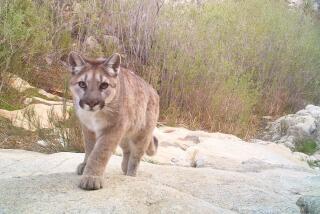Mountain lion dies of rat poison in Santa Monica Mountains
A 3-year-old mountain lion has died in the Santa Monica Mountains after being infected with rat poison, National Park Service officials announced Tuesday.
Biologists found the remains of P-47 on March 21 after his GPS collar sent out a “mortality signal” in the central portion of the Santa Monicas, park officials said. Lab results confirmed the lion had been exposed to six different anticoagulant compounds found in rat poison.
A necropsy revealed the big cat also had internal hemorrhaging in his head and lungs.
“It’s unfortunate to see an otherwise healthy mountain lion lost from what appears to be human causes,” said Seth Riley, a wildlife ecologist with the Santa Monica Mountains National Recreation Area. “In P-47’s case, it’s also a big loss because we don’t believe he had yet mated and passed along his genes, which would have been valuable since he had ancestry from north of the Santa Monicas.”
P-47 was one of the only two offspring of P-45, a mountain lion who gained national attention in 2016 after he killed several alpacas in one weekend and livestock owners got a permit to kill him. Wildlife activists intervened, and the permit to kill the mountain lion was removed. P-45, however, is believed to be dead, park officials said.
P-47 was one of the largest mountain lions in the National Park Service’s study of the big cats in the Santa Monica Mountains. He weighed 150 pounds, like his father, P-45.
Scientists think mountain lions ingest rat poison by eating animals, such as coyotes and squirrels, that either consume the poison themselves or eat smaller animals that have consumed the poison.
Researchers are still investigating how the ingested poison affects mountain lions, but they suspect it is linked to weaker immune systems that can lead to mange in the animals.
In early March, scientists captured and treated P-53, a female mountain lion who was diagnosed with mange. The skin disorder is generally rare in wild cats, but since 2002, researchers have observed a decline in the bobcat population because of the disease. Studies have shown that bobcats that have ingested rat poison are more likely to have mange and die from it, park officials said.
The relationship between rat poison and mange in mountain lions is less clear, though. Of 18 mountain lions that were tested, 17 had rat poison compounds in their system, including four diagnosed with mange.
Researchers are looking to capture images of P-53 to see how she’s doing after treatment.
P-47, however, did not have mange, National Park Service spokeswoman Kate Kuykendall said. The big cat was being monitored via GPS collar but had not been given any treatment.
“There was no indication that he was unwell,” Kuykendall said of P-47. “And visibly he looked fine in the photos we were getting. Unless the animal develops mange, there’s really no way to know that a mountain lion is being poisoned until it’s too late.”
P-47’s case is another in a series of recent mountain lion deaths attributed to poisonings. In 2017, another big cat was found dead with rat poison in his system. In that instance, a necropsy was unable to pinpoint an exact cause of death for P-41, but several anticoagulant rodenticide compounds were found in his liver.
And in 2015, P-34, a female puma, was also found to have died after ingesting rat poison. At the time, P-34’s was the first mountain lion death conclusively linked to rat poison since 2004, when scientists confirmed that two siblings died because of exposure to the toxic chemicals. Those lions, P-3 and P-4, spent most of their time in the Simi Hills, north of the 101 Freeway.
alejandra.reyesvelarde@latimes.com
Twitter: @r_valejandra
More to Read
Start your day right
Sign up for Essential California for news, features and recommendations from the L.A. Times and beyond in your inbox six days a week.
You may occasionally receive promotional content from the Los Angeles Times.







